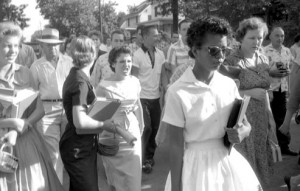Both photographers send messages about the life of an American during the 1950’s. There’s evidence show the racial look upon black and white people during that time. People did have different views and refused to look at the work but the photographs really shows life. Frank’s idea of taking photos is “point, shoot and move along”, which is a good way of taking photos because sometimes its the random photos that makes the photograph worth 1000 words. Counts photograph of Hazel show the racial discrimination during this time, it shows how the American life isn’t equal to everyone who lives there. So they were efficient in sending out the message with there photos of the American life during the 1950’s.
Contact Information
Professor Sandra Cheng
Office: Namm 602B
Office Hours: Tu/Th 9-10 am or
by appointment
Office Tel: 718-260-5003
Email: scheng@citytech.cuny.eduHelpful Links
 New York Times Arts
New York Times ArtsBlogroll
-
Recent Posts
- Re: Photographing the Beginning of the Civil Rights Movement
- Re:Discussion Topic: Street Art, Photography, and the Inside Out Project in Times Square
- Re: Tim Hetherington and Modern-day War Photography
- Response to: Tim Hetherington and Modern-day War Photography
- Photographing the Beginning of the Civil Rights Movement
Recent Comments
- Michael Lorenzo on Discussion Topic: Street Art, Photography, and the Inside Out Project in Times Square
- Michael Lorenzo on Discussion Topic: Tim Hetherington and Modern-day War Photography
- Michael Lorenzo on Discussion Topic: The Greatest War Photograph and Robert Capa
- Phalenta Pamphile on Discussion Topic: Street Art, Photography, and the Inside Out Project in Times Square
- Shantel on Discussion Topic: Photographing the Beginning of the Civil Rights Movement
Archives
Categories
Meta






